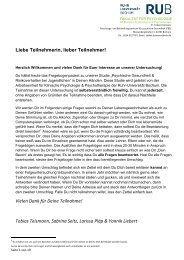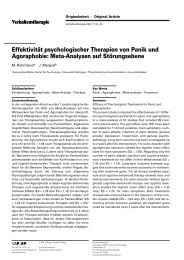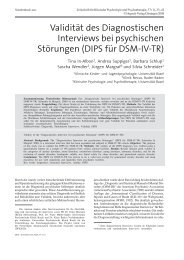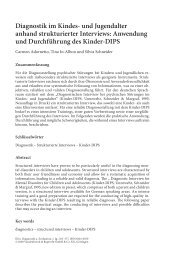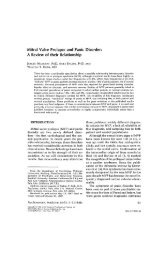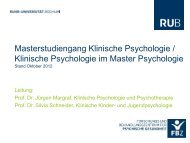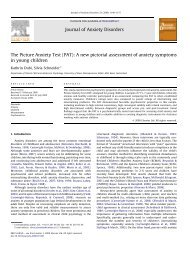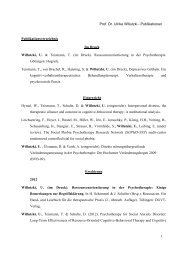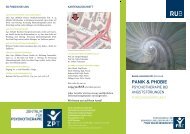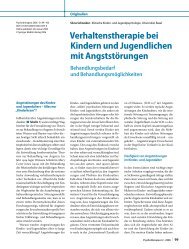Metacognitive Therapy versus Exposure and Response Prevention ...
Metacognitive Therapy versus Exposure and Response Prevention ...
Metacognitive Therapy versus Exposure and Response Prevention ...
You also want an ePaper? Increase the reach of your titles
YUMPU automatically turns print PDFs into web optimized ePapers that Google loves.
<strong>and</strong> the 2-year follow-up (ERP: z = 0.000, p = 1.000;<br />
MCT: z = –0.816, p = 0.414).<br />
Diagnostic Status <strong>and</strong> Utilization of <strong>Therapy</strong> during<br />
the 2-Year Period<br />
Based on the structured interview (Kinder-DIPS), all<br />
5 patients in the ERP condition <strong>and</strong> 4 out of 5 patients<br />
in the MCT condition did not fulfil the DSM-IV/ICD-10<br />
criteria of OCD anymore.<br />
In the ERP group, 1 patient received 6 booster sessions<br />
of ERP because of recurring OCD symptoms. At the 2-year<br />
follow-up, he was fully recovered. Another one received 13<br />
booster sessions because of recurring OCD symptoms accompanied<br />
by motor tics <strong>and</strong> ADHD symptoms. At follow-up,<br />
he showed subclinical compulsive symptoms.<br />
In the MCT group, 1 patient obtained 2 MCT booster<br />
sessions because of recurring obsessions shortly after the<br />
3-month follow-up. At the 2-year follow-up, she was fully<br />
recovered. One further patient received 15 booster sessions<br />
<strong>and</strong> additional pharmacotherapy (sertraline 50 mg/<br />
day) because of OCD symptoms <strong>and</strong> motor tics. At follow-up,<br />
he fulfilled the DSM-IV/ICD-10 criteria of mild<br />
OCD.<br />
Discussion<br />
To the authors’ knowledge, this is the first study testing<br />
MCT for childhood OCD <strong>and</strong> the first one applying<br />
two different psychotherapeutic approaches. Both MCT<br />
<strong>and</strong> ERP produced significant <strong>and</strong> robust reductions in<br />
obsessive-compulsive symptom severity. These effects<br />
were observed during a short time span (13 sessions of<br />
ERP <strong>and</strong> 9 sessions of MCT) <strong>and</strong> were still observed 2<br />
years after commencement of the therapy. All patients<br />
treated with ERP <strong>and</strong> 4 out of 5 patients treated with<br />
MCT were (nearly) fully recovered 3 months <strong>and</strong> 2 years<br />
after therapy. Two patients with comorbid Tourette’s<br />
syndrome/ADHD <strong>and</strong> with tic disorder were in need of<br />
more intensive therapeutic support after the actual therapy.<br />
This is in accordance with previous findings of a severer<br />
long-term outcome of OCD in the presence of comorbid<br />
tic disorder [36, 37] .<br />
Regarding depressive symptoms, the scores declined<br />
after therapy. The calculated differences failed to reach<br />
statistical significance, which can be attributed to the<br />
small sample size.<br />
Treatment duration, response rate, <strong>and</strong> treatment effects<br />
were comparable with previously reported studies<br />
reviewed elsewhere [3, 38] for both ERP <strong>and</strong> MCT. In 9<br />
out of these 13 studies, some children <strong>and</strong> adolescents<br />
received concomitant serotonin reuptake inhibitors/selective<br />
serotonin reuptake inhibitors pharmacotherapy<br />
without controlling for the specific effects of combination<br />
therapy. In the present study, no patient received concomitant<br />
pharmacotherapy. Hence, improvements in<br />
symptom severity can be attributed to the psychotherapeutic<br />
interventions. In addition, only a few studies comprised<br />
a follow-up assessment <strong>and</strong> if they did, the duration<br />
of follow-up in previous studies ranged from 3 to 9<br />
months. In the present study, follow-up assessments were<br />
conducted after 3 months <strong>and</strong> after 2 years, thus demonstrating<br />
stable treatment effects.<br />
Since MCT included a metacognitively modified version<br />
of ERP one could argue that MCT actually works by<br />
ERP. However, only 1 MCT patient received this kind of<br />
ERP in only 1 session. Thus, it can be ruled out that MCT<br />
is a masked kind of ERP.<br />
Limitations<br />
The present study had several limitations. First, therapists’<br />
factors could not be varied (in 9 out of 10 cases the<br />
first author was the therapist). Hence, it remains unclear<br />
to what degree therapist-specific <strong>versus</strong> treatment-specific<br />
factors accounted for the therapy success. Further,<br />
treatment integrity (i.e., the therapist’s adherence to the<br />
treatment protocol) was not assessed.<br />
The small sample does not allow generalizations to<br />
other children <strong>and</strong> adolescents with OCD, especially<br />
those with a severer or chronic disorder, or to those of<br />
younger age. The youngest patient treated with MCT was<br />
9 years old. It has yet to be clarified at which age MCT<br />
can be implemented into treatment. Similar to the patients<br />
in the previous studies, the patients in the present<br />
study suffered from moderate OCD. Further studies are<br />
required to demonstrate that patients with severer <strong>and</strong><br />
chronic OCD can benefit from ERP <strong>and</strong>/or MCT.<br />
Because of the small sample size <strong>and</strong> higher symptom<br />
severity (prior to therapy) in the MCT condition, no between-group<br />
differences were analyzed. Larger-scale<br />
comparisons between MCT <strong>and</strong> ERP are therefore warranted<br />
to investigate differences in the efficacy of the two<br />
therapy strategies.<br />
Clinical Implications <strong>and</strong> Future Directions<br />
Notwithst<strong>and</strong>ing these limitations, the present study<br />
advocates MCT to be a promising alternative to ERP.<br />
Thus, it challenges previous findings <strong>and</strong> recommendations<br />
suggesting that a successful psychotherapy for<br />
children <strong>and</strong> adolescents with OCD has to be based on<br />
262<br />
Psychother Psychosom 2006;75:257–264<br />
Simons /Schneider /Herpertz-Dahlmann



